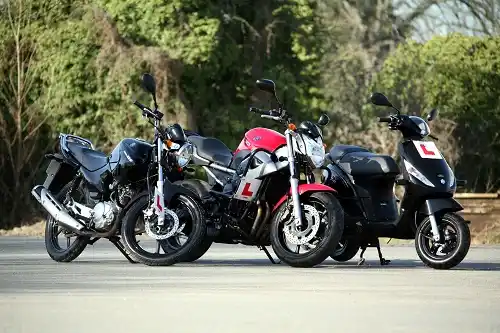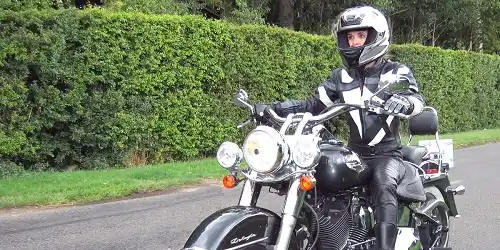Book a motorcycle test in the county of Shropshire with any of the companies listed here
Click on any of the motorcycle training schools below to view more information and check availability.
Bike Wise Motorcycle Training Shrewsbury
Meole Brace Bowling Club, Shrewsbury, Shropshire, SY3 9JT
Approx. distance: 1.3 miles
Complete Bike Training Telford
CBT Telford, Telford, Shropshire, TF7 4QR
Approx. distance: 14 miles
The Marches Motorcycle Rider Training Oswestry
Oswestry Cattle Market, Oswestry, Shropshire, SY11 4QA
Approx. distance: 16 miles
Black Country Motorcycle Training Wolverhampton
Dunstall Race Course, Wolverhampton, West Midlands, WV6 0PE
Approx. distance: 26.6 miles
Bike Wise Motorcycle Training Stafford
Unit A & B Tollgate Business Park, Stafford, Staffordshire, ST16 3HS
Approx. distance: 27.9 miles
Riders Motorcycle Training Wolverhampton
Monmore Green Greyhound Track, Wolverhampton, West Midlands, WV2 2JJ
Approx. distance: 28.4 miles
NFL Motorcycle Training Wolverhampton
Unit 16, Waterside Ind Est, Wolverhampton, West Midlands, WV2 2RH
Approx. distance: 28.7 miles
Bike Zone Motorcycle Training Crewe
82 West Street, Crewe, Cheshire, CW1 2HE
Approx. distance: 29.9 miles
Riders Motorcycle Training Dudley
Dudley Sports 7 Social Club, High Ercal Avenue, Brierly Hill, Dudley, DY5 3QH
Approx. distance: 30.3 miles
One 2 One Newcastle
Liverpool Road, Newcastle, Staffordshire, ST5 9ED
Approx. distance: 30.6 miles

Have you been hunting for a motorcycle test in Shropshire?
Have you been on the hunt for a company that can help you organise a motorcycle test in Shropshire or nearby in Shrewsbury, Wellington and Wem? Whilst price is important, the most important factor is the quality of motorcycle training. Book CBT Now has the largest listing of all motorcycle training companies in the UK. Simply enter your postcode and we will show you all of your local training companies that run motorcycle training and testing.
What are the different types of motorcycle licence I can get in Shropshire?
There are 4 main types of full motorcycle licence issued by the DVSA. The first three (AM, A1 and A2 motorcycle licences) have restrictions on the type of moped or motorcycle you can ride, the fourth (the full A motorcycle licence) has no restrictions.
The AM restricted moped licence
The A1 restricted motorcycle licence
The minimum age to take this test is 17. According to the DVSA website it will allow you to ride a "Light motorcycle up to 11 kW (and a power-to-weight ratio not more than 0.1 kW per kg) and 125 cc". This means it's up to a 125 cc motorcycle with some restrictions to make sure it cannot accelerate too fast - a really good idea when you are new to riding a motorbike!
Requirements to take the A1 motorcycle test - You must have a UK provisional or full driving licence, a valid theory test certificate and a valid CBT certificate. Once you have taken this test you will not have to keep renewing your CBT certificate every 2 years, you can ride on motorways and you can take a pillion passenger on the back of your motorbike.
The A2 restricted motorcycle licence
For this licence you need to be at least 19 years of age, have completed your CBT or have had an A1 licence for at least 2 years. As with the A1 test you also need to have a UK provisional or full driving licence and a valid theory test certificate . The main benefit of getting an A2 licence is you can ride a more powerful motorcycle. The law states a "standard motorcycle up to 35 kW (and a power-to-weight ratio not more than 0.2 kW per kg)". So it's a more powerful bike, but still not completely un-restricted. To find A2 legal motorbikes you are best visiting your local motorcycle dealer and asking them to show you the A2 legal bikes, as otherwise it's very difficult to work out just looking at the tech specs.
The full A motorcycle licence, or DAS licence.
This is the licence that allows you to ride almost any motorcycle without restrictions, so it's the ultimate motorcycle licence. No limits on power outputs or power per kg or engine size! It is also called a 'DAS' licence as it can be obtained from the 'Direct AccesS' route. There are two ways you can get this licence:
1) If you are 24 or over you can take the tests for an A licence. You must also have a UK provisional or full driving licence, a valid theory test certificate and a valid CBT certificate.
2) If you are at least 21 years of age and you have held an A2 category licence for at least 2 years. This is sometimes referred to as the 'progressive access' route as you progress from one licence to another.
When taking the test the biggest difference is that you have to use a bigger, more powerful motorcycle. It will have a power of at least 40kw and an engine cc of at least 595 cc. Your local training school will make sure you have the right size bike for your test.
There is also a flowchart (click here) that the DVLA have produced that shows these different licences and how to obtain them.
To get more detailed guidance on what licence is right for you then talk to your local motorcycle training school. You can search for them here and they are qualified to speak to you on the right type of training for you.
If I have a full car driving licence what motorcycle can I ride?
This depends on when you passed your driving test:
If you passed your car driving test before 1st February 2001
In this case you can ride a moped up to 50 cc without Learner plates and without needing a CBT. If you want to ride anything bigger then you will need to get your CBT certificate. Then you will be able to ride a restricted motorcycle up to 125 cc with Learner plates displayed.
If you passed your driving test on or after 1st February 2001
You must obtain a CBT certificate before you can ride anything. Once completed you can ride a moped or restricted motorcycle up to 125 cc.

How do I get the right training in Shropshire for the full A motorcycle licence?
The A motorcycle licence (also known as the DAS licence) is an unrestricted licence you can get when you are 24 or over. You are allowed to ride any road legal motorcycle of any power or engine size. You can also get the full A licence if you are younger than 24 if you pass your A2 restricted licence first. After holding the A2 restricted licence for 2 years you are able to take the tests for a full A licence. Given that the earliest you can take the A2 test is 19 then the earliest you could take your full A test is 21. It is essential that you get the right training for this licence as without it you are likely to hurt yourself or even worse, someone else. Use this website to enter your postcode and search for your local motorcycle training school. They are all fully qualified to advise you on the training you will need. Although saving money is something everyone wants to do, the right training will save your life. Therefore don't just focus on price, look at the quality of training on offer and the standard of training.
What can I ride in Shropshire when I am 16?
When you are just 16 years of age your choices are more limited. There is a special category of licence called the 'AM' licence (derived from 'A' licence for 'M'opeds) that you can take when you are just 16 years old. You can of course, take it when you are older too, but it's the only full license available if you are under 17 years of age. You will still need to do all of the components of a full motorcycle test, namely your theory and hazard perception tests, your compulsory basic training (CBT), your module 1 off road test and your module 2 on road practical test.
This licence allows you to ride a moped of 50 cc or less which has a top speed of 28 mph, with a passenger and without Learner plates. If you are only interested in riding a moped and nothing more then this licence could be right for you. If you want to ride a more powerful motorcycle then you might find it better to wait until you are 17. From the age of 17 onwards you can take the A1 motorcycle test which allows you to ride motorcycle up to 125 cc and with some restrictions on its power to weight ratio.